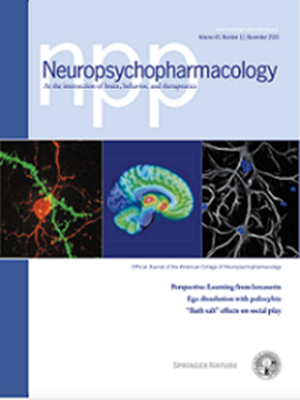Merkel cell stimulation in fear and sensory signaling
IF 6.6
1区 医学
Q1 NEUROSCIENCES
引用次数: 0
Abstract
Stress and traumatic experiences have significant and lasting effects on sensory systems. We recently identified unique expression of proteins associated with epidermal skin cells (keratinocytes) and mechanosensory Merkel cells (MC) in circulating extracellular vesicles from adult women who had experienced sexual trauma specifically during adolescence, biologically linking trauma exposure with a specific neuron-like skin cell. Here, we aimed to develop and validate a preclinical mouse model utilizing chemogenetic (DREADD Gq) activation of a population of MC. Using a reporter line, we confirmed the expected pattern of the Krt14 Cre in specific MC skin areas and that these tissues expressed relevant MC marker genes similarly between male and female mice. Chemogenetic stimulation of MC produced robust neuronal activation of the insular cortex (IC), a brain region relevant to somatosensory and valence integration. To determine if the mice could detect MC activation, home cage behaviors following CNO treatment significantly increased nest grooming time. Conditioned place preference further revealed an avoidance response following MC stimulation; an effect that was stronger in female mice. Finally, to connect back to our trauma question, we examined MC activation in fear conditioning and identified deficits in fear extinction. Overall, these studies validate utilization of this preclinical model in further investigating the mechanosensory system and its potential involvement in PTSD symptoms and therapeutic interventions. Ongoing studies will focus on critical developmental periods relevant to both MC development and sex differences associated with trauma vulnerability and potential sensory based therapeutic options for PTSD-related symptoms.

默克尔细胞刺激恐惧和感觉信号。
压力和创伤经历对感觉系统有显著而持久的影响。我们最近在青春期经历过性创伤的成年女性的循环细胞外囊泡中发现了与表皮皮肤细胞(角质形成细胞)和机械感觉默克尔细胞(MC)相关的蛋白质的独特表达,从生物学角度将创伤暴露与特定的神经元样皮肤细胞联系起来。在这里,我们旨在利用MC群体的化学遗传学(DREADD Gq)激活来开发和验证临床前小鼠模型。通过报告细胞系,我们证实了Krt14 Cre在特定MC皮肤区域的预期模式,并且这些组织在雄性和雌性小鼠之间表达相关的MC标记基因相似。MC的化学发生刺激产生了岛叶皮质(IC)的强大神经元激活,这是一个与体感和价统相关的大脑区域。为了确定小鼠是否可以检测到MC激活,CNO处理后的家笼行为显着增加了巢梳理时间。条件位置偏好进一步揭示了MC刺激后的回避反应;这种效应在雌鼠身上更为明显。最后,为了回到我们的创伤问题,我们检查了恐惧条件反射中的MC激活,并确定了恐惧消除的缺陷。总的来说,这些研究验证了该临床前模型在进一步研究机械感觉系统及其在PTSD症状和治疗干预中的潜在参与方面的应用。正在进行的研究将集中在与创伤易损性相关的MC发展和性别差异相关的关键发育时期,以及创伤后应激障碍相关症状的潜在感官治疗选择。
本文章由计算机程序翻译,如有差异,请以英文原文为准。
求助全文
约1分钟内获得全文
求助全文
来源期刊

Neuropsychopharmacology
医学-精神病学
CiteScore
15.00
自引率
2.60%
发文量
240
审稿时长
2 months
期刊介绍:
Neuropsychopharmacology is a reputable international scientific journal that serves as the official publication of the American College of Neuropsychopharmacology (ACNP). The journal's primary focus is on research that enhances our knowledge of the brain and behavior, with a particular emphasis on the molecular, cellular, physiological, and psychological aspects of substances that affect the central nervous system (CNS). It also aims to identify new molecular targets for the development of future drugs.
The journal prioritizes original research reports, but it also welcomes mini-reviews and perspectives, which are often solicited by the editorial office. These types of articles provide valuable insights and syntheses of current research trends and future directions in the field of neuroscience and pharmacology.
 求助内容:
求助内容: 应助结果提醒方式:
应助结果提醒方式:


